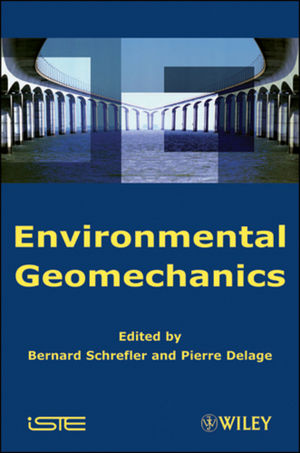Environmental GeomechanicsISBN: 978-1-84821-166-7
Hardcover
544 pages
August 2010, Wiley-ISTE
 |
||||||
Introduction xiii
Chapter 1. Debris Flows 1
Christophe ANCEY
1.1. Introduction 1
1.2. Typology of torrential flows 2
1.3. Initiation, motion and effects of debris flows 6
1.4. Modeling debris flows 12
1.5. Bibliography 30
Chapter 2. Snow Avalanches 39
Christophe ANCEY
2.1. Introduction 39
2.2. Modeling avalanches 45
2.3. Bibliography 65
Chapter 3. Instability of Soil Masses 73
Laurent VULLIET
3.1. Introduction 73
3.2. Slowly moving slopes 75
3.3. Limit state analysis 78
3.4. Case of non-saturated masses 84
3.5. Conclusion and prospects 90
3.6. Bibliography 91
Chapter 4. Instability of Rock Masses 93
François DESCOEUDRES
4.1. Introduction 93
4.2. Cliff stability and toppling 94
4.3. Contact-impact 99
4.4. Flight trajectory 101
4.5. Sliding and rolling 103
4.6. Impact on an embankment (safety embankment) 107
4.7. Capacity of the protective structures 111
4.8. Conclusion 114
4.9. Bibliography 114
Chapter 5. Subsidence Phenomena 117
Bernhard SCHREFLER and Luciano SIMONI
5.1. Subsidence caused by water withdrawal 117
5.2. Artificially-induced land uplift 141
5.3. Conclusions 146
5.4. Bibliography 147
Chapter 6. Soil Collapse due to Water Infiltration
149
Yu-Jun CUI and Pierre DELAGE
6.1. Introduction 149
6.2. The loess in Northern France 151
6.3. Conclusion 165
6.4. Bibliography 167
Chapter 7. Subsidence Induced by Fossil Fuel Extraction
171
Christian SCHROEDER, Yu-Jun CUI and Bernhard SCHREFLER
7.1. Introduction 171
7.2. Subsidence due to coal extraction 172
7.3. Recap of the basic Barcelona mode1 176
7.4. Subsidence due to oil exploitation 179
7.5. Subsidence due to the exploitation of gas reservoirs 185
7.6. Acknowledgements 197
7.7. Bibliography 197
Chapter 8. Deterioration of Stone in Monuments 201
Véronique VERGÈS-BELMIN
8.1. Introduction 201
8.2. Intrinsic degradation factors 202
8.3. Extrinsic degradation factors 214
8.4. Acknowledgements 240
8.5. Bibliography 240
Chapter 9. The Physics of Water Transfer in Stone
247
Jean-Paul LAURENT
9.1. General concepts and terminology 247
9.2. Water in stones: capillarity 250
9.3. Modeling water transfer in stone 263
9.4. Bibliography 271
Chapter 10. Experimental Techniques for Characterizing
Alterations 275
Claude BRUNJAIL, Guy BASTIAN, Grégoire CHÉNÉ and
Véronique VERGÈS-BELMIN. Updated by Philippe BROMBLET
10.1. Laboratory and in situ testing 275
10.2. Hydric and thermal transfers: specific techniques 296
10.3. Bibliography 303
Chapter 11. Case Studies 313
Jean GODIN, Claude BRUNJAIL, Véronique VERGÈS-BELMIN and
Ann BOURGÈS
11.1. Notre-Dame-la-Grande Church in Poitiers, in situ study 313
11.2. Research on earthen plaster stabilized with bitumen and
polychrome decoration: Navrongo
cathedral, North Ghana 321
11.3. Bibliography 330
Chapter 12. The Nature and Survey of Soil Pollution
333
Abdelmalek BOUAZZA, Pierre DELAGE and Michel WOJNAROWICZ
12.1. Introduction 333
12.2. The nature of soil pollution 334
12.3. The survey of contaminated sites 339
12.4. Conclusions 356
12.5. Bibliography 357
Chapter 13. Retention and Transfer of Soluble Chemical
Pollutants: Mechanisms and Numerical
Modeling 361
Robert CHARLIER and Jean-Pol RADU
13.1. Introduction 361
13.2. Ideal pollutant transport in an ideal continuous medium 362
13.3. Pollutant retention phenomena 366
13.4. Balance equations 369
13.5. Numerical modeling of transport by advection 371
13.6. Finite elements modeling of the problem with advection and diffusion 372
13.7. Examples and applications 380
13.8. Conclusions 388
13.9. Acknowledgments 388
13.10. Bibliography 389
13.11. Notations table 390
Chapter 14. Retention and Transfer of Pollution by
Hydrocarbons: Mechanisms and Numerical Modeling 393
Bernhard SCHREFLER and Pierre DELAGE
14.1. Introduction 393
14.2. Mechanisms 393
14.3. Numerical modeling 398
14.4. Conclusion 415
14.5. Bibliography 416
Chapter 15. Methods of Soil Environmental Remediation
419
Abdelmalek BOUAZZA, Michel WOJNAROWICZ and Mario MANASSERO
15.1. Introduction 419
15.2. Pollution control techniques 420
15.3. Active containment in situ 423
15.4. Passive treatment in situ 425
15.5. Active treatment in situ 429
15.6. Conclusions 453
15.7. Bibliography 454
Chapter 16. Liners for Waste Containment Facilities
459
Abdelmalek BOUAZZA, Michel WOJNAROWICZ and Mario MANASSERO
16.1. Introduction 459
16.2. Types of lining systems and definition of basic components 462
16.3. Mass balance of the contaminants 464
16.4. Functions, performance and modeling 465
16.5. Environmental impact evaluation (risk analysis) 466
16.6. Bottom barriers 469
16.7. Equivalence of liner systems 481
16.8. Composite liners 491
16.9. Conclusions 501
16.10. Bibliography 502
List of Authors 509
Index 513



